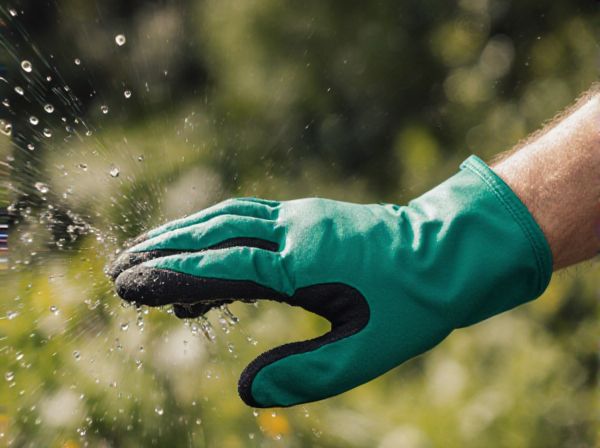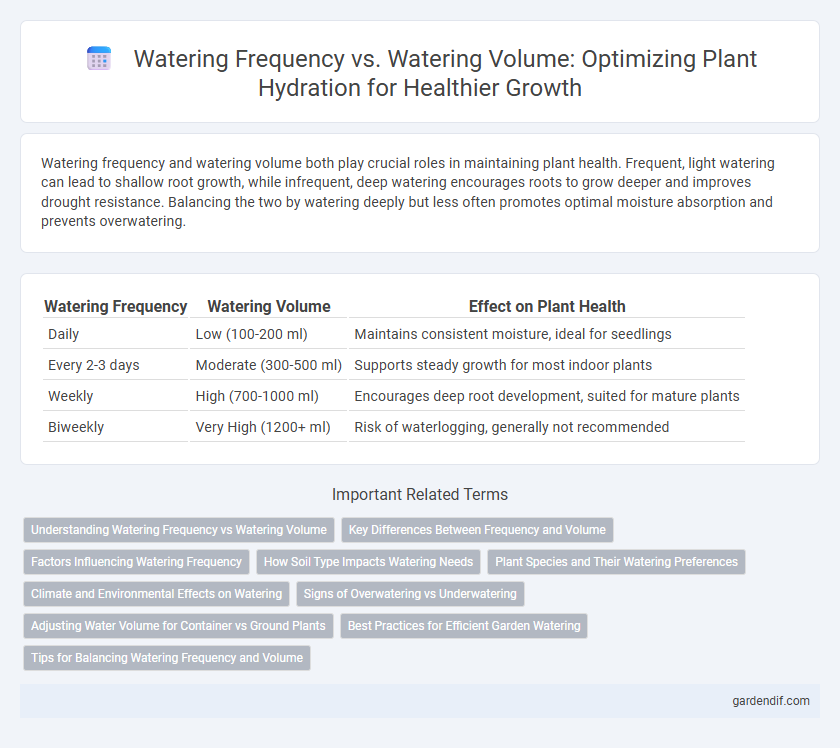
Watering frequency vs Watering volume Illustration
Watering frequency and watering volume both play crucial roles in maintaining plant health. Frequent, light watering can lead to shallow root growth, while infrequent, deep watering encourages roots to grow deeper and improves drought resistance. Balancing the two by watering deeply but less often promotes optimal moisture absorption and prevents overwatering.
Table of Comparison
| Watering Frequency | Watering Volume | Effect on Plant Health |
|---|---|---|
| Daily | Low (100-200 ml) | Maintains consistent moisture, ideal for seedlings |
| Every 2-3 days | Moderate (300-500 ml) | Supports steady growth for most indoor plants |
| Weekly | High (700-1000 ml) | Encourages deep root development, suited for mature plants |
| Biweekly | Very High (1200+ ml) | Risk of waterlogging, generally not recommended |
Understanding Watering Frequency vs Watering Volume
Watering frequency and watering volume are critical factors in effective plant hydration, where frequency refers to how often you water, and volume pertains to the amount of water delivered each time. High watering frequency with low volume can lead to shallow root growth and increased evaporation, while low frequency with high volume encourages deep root development and better drought resistance. Balancing these variables based on plant species, soil type, and environmental conditions optimizes water use efficiency and promotes healthy plant growth.
Key Differences Between Frequency and Volume
Watering frequency refers to how often plants receive water, while watering volume is the amount of water applied each time. High frequency with low volume promotes shallow root growth, increasing vulnerability to drought, whereas low frequency with high volume encourages deep root development for better drought resistance. Understanding these differences helps optimize irrigation schedules for plant health and water conservation.
Factors Influencing Watering Frequency
Watering frequency depends primarily on soil type, with sandy soils requiring more frequent watering due to rapid drainage, while clay soils retain moisture longer, reducing the need for frequent irrigation. Plant species and their root depth also influence watering schedules, as deep-rooted plants access moisture from deeper soil layers, allowing for less frequent watering but with higher volume per session. Environmental factors such as temperature, humidity, and rainfall patterns significantly impact watering frequency by altering evaporation rates and soil moisture retention.
How Soil Type Impacts Watering Needs
Soil type significantly impacts watering frequency and volume by determining water retention and drainage capacity. Sandy soils require more frequent watering with lower volumes due to rapid drainage, while clay soils retain moisture longer, needing less frequent but deeper watering to prevent waterlogging. Loam soils balance retention and drainage, supporting moderate watering schedules that optimize plant hydration and root health.
Plant Species and Their Watering Preferences
Different plant species require tailored watering frequencies and volumes to thrive; succulents need infrequent but deep watering, while tropical plants prefer regular, moderate amounts to maintain consistent moisture levels. Overwatering or underwatering can stress plants depending on their natural habitats, with cacti tolerating drought but ferns needing consistently moist soil. Understanding species-specific watering preferences ensures optimal growth and reduces the risk of root rot or dehydration.
Climate and Environmental Effects on Watering
Watering frequency and volume must adjust according to climate variables such as temperature, humidity, and soil type to optimize plant hydration without causing runoff or drought stress. In arid climates, less frequent but deeper watering promotes root growth and conserves water, whereas humid environments often require lighter, more frequent watering to prevent fungal diseases. Environmental factors like wind and soil permeability also influence evapotranspiration rates, making precise watering schedules critical for efficient water use and healthy plant growth.
Signs of Overwatering vs Underwatering
Overwatering often leads to yellowing leaves, root rot, and consistently soggy soil, while underwatering causes wilting, dry soil, and crispy leaf edges. Watering frequency should balance the soil's moisture retention capacity, with less frequent but deeper watering promoting healthy root growth. Monitoring plant-specific moisture needs and observing signs like leaf texture and soil dryness ensures optimal watering volume and frequency to avoid stress from overwatering or underwatering.
Adjusting Water Volume for Container vs Ground Plants
Adjusting water volume for container plants requires careful monitoring of soil moisture due to limited root space, often needing smaller, more frequent waterings to prevent overwatering or root rot. Ground plants, with deeper and more expansive root systems, typically benefit from larger volumes of water applied less frequently, promoting deeper root growth and drought resilience. Tailoring watering volume to the plant's environment ensures optimal hydration and supports healthy development.
Best Practices for Efficient Garden Watering
Optimal garden watering balances frequency and volume to maximize water efficiency and plant health. Water deeply but less often, encouraging roots to grow deep and improving drought resistance. Employing drip irrigation or soaker hoses delivers water directly to the root zone, reducing evaporation and runoff for more effective hydration.
Tips for Balancing Watering Frequency and Volume
Optimal watering balances frequency and volume by considering plant species, soil type, and climate conditions. Deep watering less often promotes root growth, while frequent light watering may cause shallow roots and increase moisture loss. Monitoring soil moisture with a sensor ensures precise adjustments, preventing overwatering and encouraging healthy plant development.
Watering frequency vs Watering volume Infographic

 gardendif.com
gardendif.com